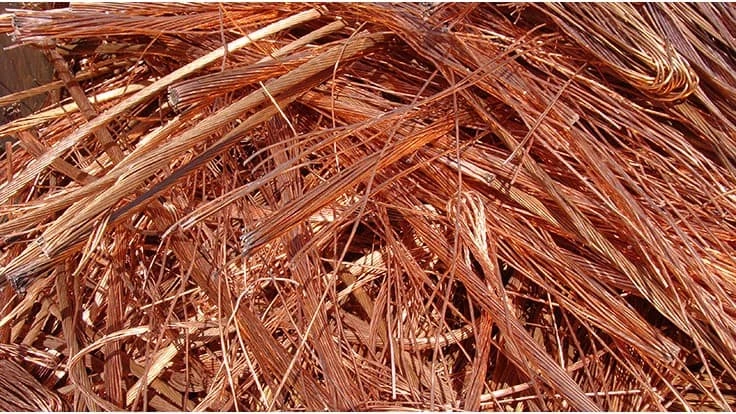
Photo by Recycling Today staff.
The surging price of copper was the focus of attention at a nonferrous metals roundtable on June 23, which was part of the online International Recycling Week event. However, panelists said behind the bullishness lie concerns including protectionism, supply constraints and shipping limitations.
Natalia Zholud, a senior trader and head of business development at Belarus-based TRM Group, said the fundamentals underlying copper’s soaring price globally are legitimate. “I do think there is a significant base behind the recent copper rally,” she stated.
Pointing the Paris Accord, the European Union Green Deal and booming electric vehicle (EV) support around the world, Zholud added, “Maybe the copper market is not optimistic enough. There are so many fundamentals behind demand.”
Salam al Sharif, chairman of United Arab Emirates (UAE)-based Sharif Metals Group, said the soaring demand tied to decarbonization efforts is clashing with the copper market’s fundamentals. “I’m not sure how sustainable that is,” he commented. “If you want to things to go green, there is a big cost. To generate it, distribute it and store it [requires] good old copper connectivity, and it is indispensable and [impractical] to use any other metal.”
Susie Burrage, managing director of United Kingdom-based Recycled Products Ltd., said when copper prices soar too high, “a switch from copper to aluminum” can gain support among manufacturers. “I know the conductivity isn’t as good—I think around 62 percent—but it’s a lot lighter,” she said of aluminum in the electrical market. “So, there might be a bit of a switch [when] it’s about a quarter of the price.”
However, said Burrage, citing a recent forecast from metals producer Glencore that pegs global copper demand doubling to reach 60 million tons per year annually, “We’re definitely going to need [more copper] if governments follow through on their plans.” EVs alone contain four times as much copper on average as internal combustion engine vehicles, she remarked.
Getting copper scrap from point A to point B amidst a global container shipping network that has rankled the recycling sector is providing additional problems. In her region, said Zholud, “For some areas, getting a container can decide whether you do business or do not do business. It should not be that way. We, as business owners, have other issues, and containers should be the last thing that needs to be your daily headache.”
Sanjay Mehta, a director of the India-based MTC Group, predicted “this cost will not go down.” He said the shipping lines have “got a taste” for the profits to be made in the current market. “We have to live with the situation,” he declared.
Mehta expressed concern about the consolidated nature of the global container shipping industry, comparing it with trying to find alternatives to Google in the search engine market. “I don’t think we have any kind of option in availability of containers or reduction in freight,” he stated, until or unless new players enter the sector, which will take several years, Mehta suggested.
For scrap recyclers in Europe, being able to ship at all is becoming a concern, as the EU government considers whether nonferrous scrap—categorized as a “waste” there—can legally be exported under its evolving regulatory framework.
When asked by moderator Sean Davidson of The Davis Index if all these factors will prompt more melting capacity closer to where scrap is generated, the panelists largely agreed such an outcome is conceivable.
Sharif pointed to the clampdown on lead-acid battery exports nearly 30 years ago as one that created an opportunity for his company to enter the lead battery secondary smelting sector. “We had vertical integration and we made money on it; it’s a model you have to adapt,” he commented.
Burrage said there is not a single large-scale secondary copper producer in the U.K., but remarked, “There are always people in our industry, entrepreneurs, who feel if there is money to be made then they will melt it in their own country.” She added, if shipping “resolves itself, then that makes it economical for people to go on” exporting.
Zholud pointed to the prior history of self-sustaining production in the former Soviet bloc and commented, “If you have local outlets, this is a way out. It might not be that bad of an idea.”
Sharif urged roundtable listeners to support the Bureau of International Recycling (BIR) and other trade associations to help influence such issues rather than merely react to them.
Despite the woes, panelists were largely optimistic about the future of nonferrous scrap recycling and the state of the economy in the nations and regions represented.
Although India has been through a traumatic second wave with COVID-19, Mehta stated, “Now, we are geared up, and our country is coming back. Every country has infused a good amount of money [into economies.] The next two to five years, a good amount of business is going to come from every country.”
International Recycling Week was organized by United Arab Emirates-based Waste & Recycling Middle East & Africa magazine.
Latest from Recycling Today
- Aqua Metals secures $1.5M loan, reports operational strides
- AF&PA urges veto of NY bill
- Aluminum Association includes recycling among 2025 policy priorities
- AISI applauds waterways spending bill
- Lux Research questions hydrogen’s transportation role
- Sonoco selling thermoformed, flexible packaging business to Toppan for $1.8B
- ReMA offers Superfund informational reports
- Hyster-Yale commits to US production





